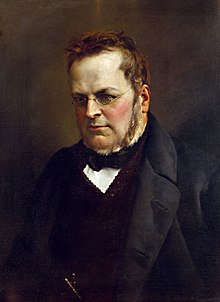
Back Camillo Benso di Cavour Afrikaans Camillo Benso di Cavour AN كاميلو بنسو Arabic كاميلو بنسو ARZ Camillo Benso AST Kamillo Kavur Azerbaijani Камило Бенсо ди Кавур Bulgarian Camillo Benso di Cavour BS Camillo Benso di Cavour Catalan Camillo Benso Cavour Czech
This article needs additional citations for verification. (February 2024) |
The Count of Cavour | |
|---|---|
 Portrait by Antonio Ciseri, 1861 | |
| 1st Prime Minister of Italy | |
| In office 23 March 1861 – 6 June 1861 | |
| Monarch | Victor Emmanuel II |
| Preceded by | Himself as Prime Minister of the Kingdom of Sardinia |
| Succeeded by | Bettino Ricasoli |
| Prime Minister of the Kingdom of Sardinia | |
| In office 21 January 1860 – 23 March 1861 | |
| Monarch | Victor Emmanuel II |
| Preceded by | Alfonso Ferrero La Marmora |
| Succeeded by | Himself as Prime Minister of Italy |
| In office 4 November 1852 – 19 July 1859 | |
| Monarch | Victor Emmanuel II |
| Preceded by | Massimo D'Azeglio |
| Succeeded by | Alfonso Ferrero La Marmora |
| Minister of Finances | |
| In office 19 April 1851 – 11 May 1852 | |
| Monarch | Victor Emmanuel II |
| Prime Minister | Massimo D'Azeglio |
| Preceded by | Giovanni Nigra |
| Succeeded by | Luigi Cibrario |
| Minister of Agriculture and Trade | |
| In office 11 October 1850 – 11 May 1852 | |
| Monarch | Victor Emmanuel II |
| Prime Minister | Massimo D'Azeglio |
| Preceded by | Pietro De Rossi di Santarosa |
| Succeeded by | Giuseppe Natoli (1861) |
| Member of the Chamber of Deputies | |
| In office 30 June 1848 – 17 March 1861 | |
| Constituency | Turin |
| Personal details | |
| Born | Camillo Paolo Filippo Giulio Benso 10 August 1810 Turin, First French Empire |
| Died | 6 June 1861 (aged 50) Turin, Kingdom of Italy |
| Nationality | Italian |
| Political party | Historical Right |
| Signature | |
Camillo Paolo Filippo Giulio Benso, Count of Cavour, Isolabella and Leri (Italian: [kaˈmillo ˈbɛnso]; 10 August 1810 – 6 June 1861), generally known as the Count of Cavour (/kəˈvʊər/ kə-VOOR; Italian: Conte di Cavour [ˈkonte di kaˈvur]) or simply Cavour, was an Italian politician, statesman, businessman, economist, and noble, and a leading figure in the movement towards Italian unification.[1] He was one of the leaders of the Historical Right and Prime Minister of the Kingdom of Sardinia from 1852, a position he maintained (except for a six-month resignation) until his death, throughout the Second Italian War of Independence and Giuseppe Garibaldi's campaigns to unite Italy. After the declaration of a united Kingdom of Italy, Cavour took office as the first Prime Minister of Italy; he died after only three months in office and did not live to see the Roman Question solved through the complete unification of the country after the Capture of Rome in 1870.
Cavour put forth several economic reforms in his native region of Piedmont, at that time part of the Kingdom of Sardinia, in his earlier years and founded the political newspaper Il Risorgimento. After being elected to the Chamber of Deputies, he quickly rose in rank through the Piedmontese government, coming to dominate the Chamber of Deputies through a union of centre-left and centre-right politicians. After a large rail system expansion program, Cavour became prime minister in 1852. As prime minister, Cavour successfully negotiated Piedmont's way through the Crimean War, the Second Italian War of Independence, and Garibaldi's Expedition of the Thousand, managing to manoeuvre Piedmont diplomatically to become a new great power in Europe, controlling a nearly united Italy that was five times as large as Piedmont had been before he came to power.
English historian Denis Mack Smith says Cavour was the most successful parliamentarian in Italian history, but he was not especially democratic. Cavour was often dictatorial, ignored his ministerial colleagues and parliament, and interfered in parliamentary elections. He also practised trasformismo and other policies which were carried over into post-Risorgimento Italy.[2][3]
- ^ Camillo Benso, Conte di Cavour (Italian statesman). biography.yourdictionary.com
- ^ Denis Mack Smith, "Cavour and Parliament" Cambridge Historical Journal 13#1 (1957): 37–57
- ^ Denis Mack Smith, Cavour (1985).